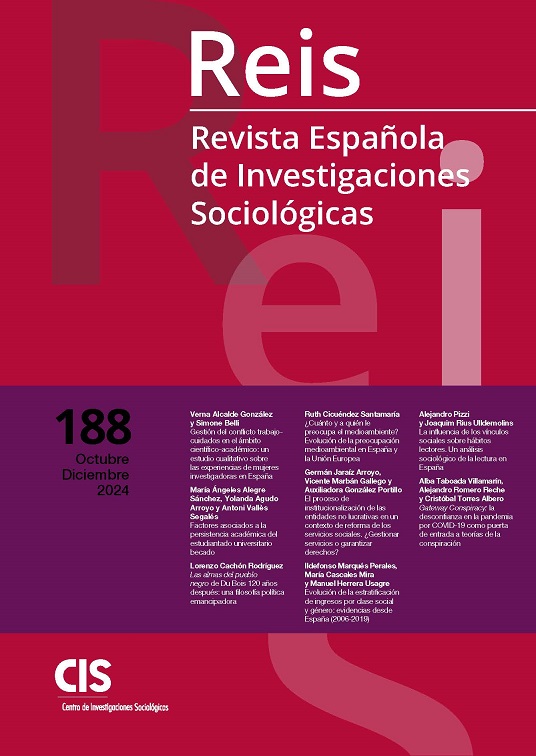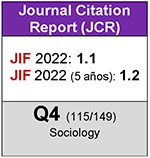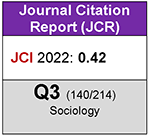"Gateway Conspiracy”: Distrust of the COVID-19 pandemic as a gateway to conspiracy theories.
DOI:
https://doi.org/10.5477/cis/reis.188.145-164Keywords:
Network Analysis, Big Data , Misinformation, Social Networks, Sociology, Conspiracy Theories, TwitterAbstract
The article examines how distrust towards the COVID-19 pandemic has served as a catalyst for the diffusion of conspiracy theories. It discusses the nature of conspiracy theories, their relationship to institutional distrust, and their representation in social media. The study's methodology includes analyzing hashtags from over two million tweets, through network analysis, in order to understand how different conspiracy theories relate to each other and how certain theories act as "gateways" to others. The findings suggest that there are logical connections between different conspiracy theories, influenced by distrust towards specific institutions and amplified by the COVID-19 crisis. It concludes that the combination of conspiracy theories is not random, but follows an internal logic based on distrust, since they are interconnected in an internally coherent way in the context of the pandemic.
Downloads
References
Ball, J. (2023). The Other Pandemic: How QAnon Contaminated the World. Londres: Bloomsbury.
Bastian, Mathieu; Heymann, Sébastien; Jacomy, Mathieu (2009). "Gephi: An Open Source Software for Exploring and Manipulating Networks." Tercera Conferencia Internacional ICWSM, 3(1), 361-362. doi: 10.13140/2.1.1341.1520. DOI: https://doi.org/10.1609/icwsm.v3i1.13937
Ben-Itto, H. (2020). The Lie That Will Not Die. The Protocols of the Elders of Zion. Elstree: Vallentine Mitchell.
Bromley, D., & Richardson, J. (2023). The QAnon conspiracy narrative: Understanding the social construction of danger. En M. K. Miller, The Social Science of QAnon (págs. 159-175). Cambridge: Cambridge University Press. DOI: https://doi.org/10.1017/9781009052061.014
Brotherton, R. (2015). Suspicious Minds. Why We Believe in Conspiracy Theories. Nueva York: Bloomsbury. DOI: https://doi.org/10.5040/9781472944528
Butter, M. (2020). The Nature of Conspiracy Theories. Cambridge: Polity Press. DOI: https://doi.org/10.4324/9780429452734-5_10
Butter, M., & Knight, P. (eds.) (2023). Covid Conspiracy Theories in Global Perspective. Londres: Routledge. DOI: https://doi.org/10.4324/9781003330769
Byford, J. (2015). Conspiracy Theories. A Critical Introduction. Basingstoke: Palgrave Macmillan.
Castanho Silva, B., Vegetti, F., & Littvay, L. (2017). The elite is up to something: Exploring the relation between populism and belief in conspiracy theories. Swiss Political Science Review, 423-443. DOI: https://doi.org/10.1111/spsr.12270
Dow, B., Johnson, A., Wang, C., Whitson, J., & Menon, T. (2021). The COVID-19 pandemic and the search for structure: Social media and conspiracy theories. Social and Personality Psychology Compass, e12636. DOI: https://doi.org/10.1111/spc3.12636
Eberl, J.-M., Huber, R., & Greussing, E. (2021). From populism to the “plandemic”: Why populists believe in COVID-19 conspiracies. Journal of Elections, Public Opinion and Parties, 272-284. DOI: https://doi.org/10.1080/17457289.2021.1924730
Goertzel, T. (1994). Belief in conspiracy theories. Political Psychology, 731-742. DOI: https://doi.org/10.2307/3791630
Gualda, Estrella; Borrero, Juan Diego; Carpio Cañada, José (2014). "The 'Spanish Revolution' on Twitter (2): Networks of hashtags and individual and collective actors regarding evictions in Spain." Redes. Revista hispana para el análisis de redes sociales, 26(1), 1. doi: 10.5565/rev/redes.535. DOI: https://doi.org/10.5565/rev/redes.535
Gualda, E., & Rúas, J. (2019). Teorías de la conspiración, credibilidad y confianza en la información. Communication and Society, 179-193.
Guinjoan, M. & Galais, C. (2023). I want to believe: The relationship between conspiratorial beliefs and populist attitudes in Spain. Electoral Studies 81, 102574. DOI: https://doi.org/10.1016/j.electstud.2022.102574
Hameleers, M. (2020). They are selling themselves out to the enemy! The content and effects of populist conspiracy theories. International Journal of Public Opinion Research, 38-56. DOI: https://doi.org/10.1093/ijpor/edaa004
Harambam, J. (2017). 'The Truth is Out There': Conspiracy Culture in an Age of Epistemic Instability. Rotterdam: Erasmus University Rotterdam.
Kim, Younghoon; Seo, Jiwon (2020). "Detection of Rapidly Spreading Hashtags via Social Networks." IEEE Access, 8, 39847-60. doi: 10.1109/ACCESS.2020.2976126. DOI: https://doi.org/10.1109/ACCESS.2020.2976126
Knight, P. (2000). Conspiracy Culture: From the Kennedy Assassination to the X-Files. Londres: Routledge.
Langguth, Johannes; Schroeder, Thilo; Filkuková, Petra; Brenner, Stefan; Phillips, Jesper; Pogorelov, Konstantin (2023). "COCO: An Annotated Twitter Dataset of COVID-19 Conspiracy Theories." Journal of Computational Social Science. doi: 10.1007/s42001-023-00200-3. DOI: https://doi.org/10.1007/s42001-023-00200-3
Lozares, C.; López-Roldán, P.; Bolíbar, M.; Muntanyola, D. (2013). "La centralidad en las redes sociales: medición, correlación y aplicación." Metodología de Encuestas, 15(1), 77-97.
Nefes, T. S., Präg, P., Romero Reche, A., & Pereira Puga, M. (2023). Believing in conspiracy theories in Spain during the COVID-19 pandemic: Drivers and public health implications. Social Science & Medicine. DOI: https://doi.org/10.1016/j.socscimed.2023.116263
Ortiz, Ana María (2020). "Unas 3.000 personas, sin mascarilla ni distancia, protestan en Colón contra las medidas antiCovid." El Mundo. Disponible en: https://www.elmundo.es/espana/2020/08/16/5f396a9c21efa0fd5a8b45fc.html
Pierre, J. (2023). Down the conspiracy theory rabbit hole: How does one become a follower of QAnon? En M. K. Miller, The Social Science of QAnon (págs. 17-32). Cambridge: Cambridge University Press. DOI: https://doi.org/10.1017/9781009052061.005
Pirro, A., & Taggart, P. (2022). Populists in power and conspiracy theories. Party Politics, 413-423. DOI: https://doi.org/10.1177/13540688221077071
Reinemann, C., Haas, A., & Rieger, D. (2022). “I don’t care,’cause I don’t trust them!” The impact of information sources, institutional trust, and right-wing populist attitudes on the perception of the COVID-19 pandemic during the first lockdown in Germany. SCM Studies in Communication and Media, 132-168. DOI: https://doi.org/10.5771/2192-4007-2022-1-132
Richardson, J. T. (2023). Recruitment to QAnon: Ordinary persuasion and human agency or 'brainwashing'? En M. K. Miller, The Social Science of QAnon (págs. 104-120). Cambridge: Cambridge University Press. DOI: https://doi.org/10.1017/9781009052061.010
Rodríguez Pascual, I., Gualda Caballero, E., Morales Marente, E., & Palacios Gálvez, M. (2021). ¿Está asociado el uso de redes sociales digitales a las teorías de la conspiración? Evidencias en el contexto de la sociedad andaluza. Revista Española de Investigaciones Sociológicas, 101-119. DOI: https://doi.org/10.5477/cis/reis.173.101
Romero Reche, A. (2023a). A communist coup by lockdown. Covid conspiracy theories in Spain. En M. Butter, & P. Knight, Covid Conspiracy Theories in Global Perspective (págs. 309-319). Londres: Routledge. DOI: https://doi.org/10.4324/9781003330769-28
Romero Reche, A. (2023b). Sociología de las teorías de la conspiración. Madrid: Síntesis.
Romero Reche, A., & Nefes, T. S. (2022). La racionalidad de las teorías conspirativas: una aproximación a partir de Max Weber y Raymond Boudon. Revista CENTRA de Ciencias Sociales, 11-30. DOI: https://doi.org/10.54790/rccs.24
Rothschild, M. (2022). The Storm is Upon Us. How QAnon Became a Movement, Cult and Conspiracy Theory of Everything. Londres: Melville House.
Schaub, Michael T.; Delvenne, Jean-Charles; Rosvall, Martin; Lambiotte, Renaud (2017). "The Many Facets of Community Detection in Complex Networks." Applied Network Science, 2(1), 4. doi: 10.1007/s41109-017-0023-6. DOI: https://doi.org/10.1007/s41109-017-0023-6
SciPy (2023). "Fundamental algorithms for scientific computing in Python." Recuperado de: https://scipy.org/
Tangherlini, T., Shahsavari, S., Holur, P., & Roychowdhury, V. (2023). QAnon, folkore and conspirational consensus: A case study in the computational analysis of conspiracy theory narratives. En M. K. Miller, The Social Science of QAnon (págs. 234-251). Cambridge: Cambridge University Press. DOI: https://doi.org/10.1017/9781009052061.019
Thalmann, K. (2019). The Stigmatization of Conspiracy Theory Since the 1950s. 'A Plot to Make Us Look Foolish'. Londres: Routledge. DOI: https://doi.org/10.4324/9780429020353
Tweepy (2023). "Tweepy: Python library for accessing the Twitter API." Recuperado de: https://www.tweepy.org/
Uscinski, J. E., & Parent, J. (2014). American Conspiracy Theories. Nueva York: Oxford University Press. DOI: https://doi.org/10.1093/acprof:oso/9780199351800.001.0001
van der Linden, S., Panagopoulos, C., Azevedo, F., & Jost, J. (2021). The paranoid style in American politics revisited: An ideological asymmetry in conspiratorial thinking. Political Psychology, 23-51. DOI: https://doi.org/10.1111/pops.12681
Van Proijeen, J.-W., Cohen Rodrigues, T., Bunzel, C., Georgescu, O., Komáromy, D., & Krowuel, A. (2022). Populist gullibility: Conspiracy theories, news credibility, bullshit receptivity, and paranormal belief. Political Psychology, 1061-1079. DOI: https://doi.org/10.1111/pops.12802
West, M. (2020). Escaping the Rabbit Hole. How to Debunk Conspiracy Theories Using Facts, Logic and Respect. Nueva York: Skyhorse Publishing.
Winter, T., Riordan, B., Scarf, D., & Jose, P. (2022). Conspiracy beliefs and distrust of science predicts reluctance of vaccine uptake of politically right-wing citizens. Vaccine, 1896-1903. DOI: https://doi.org/10.1016/j.vaccine.2022.01.039
Wojczewski, T. (2022). Conspiracy theories, right-wing populism and foreign policy: The case of the Alternative for Germany. Journal of International Relations and Development, 130-158. DOI: https://doi.org/10.1057/s41268-021-00218-y
Downloads
Published
How to Cite
Issue
Section
License
Copyright (c) 2024 Revista Española de Investigaciones Sociológicas

This work is licensed under a Creative Commons Attribution-ShareAlike 4.0 International License.
Permite Compartir — copiar y redistribuir el material en cualquier medio o formato, Adaptar — remezclar, transformar y construir a partir del material para cualquier propósito, incluso comercialmente.








